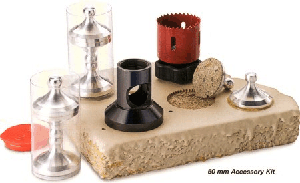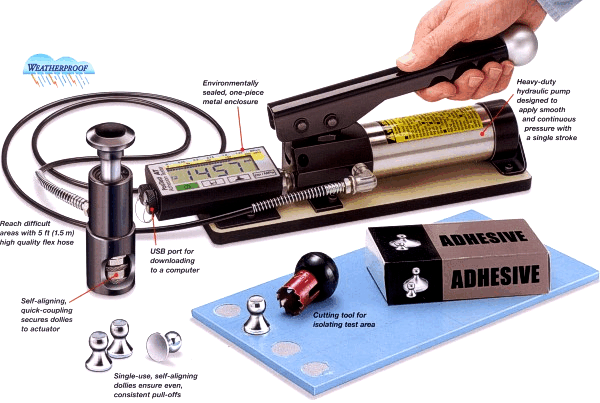 First, Cross- Cutting Testing Procedure:
First, Cross- Cutting Testing Procedure:
1. To cut a 10X10MM coated surface (flat) into 100 grids with a sharp knife, with each grid occupying an area of 1 mm2 (make sure all the incisions should show the base material and the cuts should not be tilted)
2. To attach 3M adhesive tape to the cut surface and press it tight with your finger, and then rapidly pull up the tape in a vertical direction.
3. To repeat the action for three times along the same direction, please note that each time new tape should be used.
4. To rotate the material for 90 degrees, and test the coated material for three times in the same way, please note that each time new tape should be used.
5. To observe how much coating has been peeled off from the grids.
Determination: A cross- cutting test is successful if no coating has peeled off from the grids (and the result is acceptable if no more than 10% of the coating is peeled off)
Second, Fingernail Scratch Testing Procedures:
1. To cut open 20 deep marks on a coated surface (flat) with a sharp knife ( 10 vertically and 10 horizontally), each with a length of 10mm. (make sure all the incisions should show the base material)
2. To scratch horizontally on the coating with nails.
3. To observe how much coating has been peeled off.
Determination: The coating is qualified if no coating has been peeled off.
Third, Boiling Water Testing Procedures:
1. Make sure the product has successfully gone through the cross-cut test.
2. to choose two other sections of the product and conduct cross-cutting again and then boil the product for 30 minutes (make sure the product is completely submerged and the water will always be boiling)
3. After the product is completely cooled, remove the product and dry the water stains.
4. To conduct 3M tape test and the nail scratching test on these two sections.
5. To observe the condition of coating.
Determination: If there has been no wrinkling and peeling off in the coating, the coating has gone through the boiling water test.
Fourth, the Reliability Testing Procedures
1. To assemble the electrical-heating plate into the machine?and conduct reliability test on the coated surface under a fixed temperature.
2. For Sandwich-maker series, waffle-maker series, and hamburger maker series, the average temperature should be 220±20?.
3. For cooking iron series the temperature should be 260?±20?
4. For the electric iron the surface temperature should be 230?±20?
5. Set these products on for ten hours followed by power dump at night for 14 hours, and that is regarded as a cycle. The test should last for 7 cycles continuously.
Determination: After the test, there should not have been significant color changes, scorch, bubble, crack and peeling off of the coating, melt of the coating (the base material of the electric hot tray is exposed )or other phenomena on the coated surface.
Fifth, the Long-term Testing Procedures
1. If the machine has successfully gone through the reliability test and the coated surface is reconfirmed under the fixed temperature, it should be on the long-term lifetime testing for 760 cycles continuously, with a cycle of power on an hour and off an hour.
2. Determination: After the test, there should not have been significant color changes, scorch, bubble, crack and peeling off of the coating, melt of the coating (the base material of the electric hot tray is exposed )or other phenomena on the coated surface.
Sixth, Salinification Testing Procedures?
Immersion
1. To immerse the product into 3 percent NACL for 24 hours.
2. To remove the product, dry the water stains and observe if there is quality abnormity. Conduct cross- cutting test and nail scratching test.
Boiling
1. To pour an appropriate amount of 3 percent NACL solution into the coated electric hot tray
2. To switch on the electric hot tray till the water dries out. After that, pour an appropriate amount of solution again and wait for the water dries out.
3. To pour some solution a third time and heat it till steaming appears. Cut off the power as soon as the steaming appears and lay it aside for 24 hours.
4. To pour the remaining solution away and dry the water stains. Conduct cross- cutting test and nail scratching test.
5. Determination: It is qualified if there has been no peeling off or wrinkling in the test of the coating.
Seventh, Pencil Hardness Testing Procedures:
1.To sharpen a pencil with 2 to 3 mm of the lead revealed
2. To lay an abrasive paper on a flat table and grind the lead on it with the pencil vertically downwards.
3. To select a center on a smooth part of the coating and move the pencil more than 20mm forward on the coated surface with the angle of 45 degrees.
4. To rotate the pencil 120 degrees and move more than 20mm forward parallelly.
To rotate the pencil 120 degrees again and move more than 20mm parallelly. 3 marks have been left on the coated surface.
5. To rub the three marks with a rubber and observe the condition of the coated surface.
6. Determination: If the marks can be rubbed totally and leave no marks at all, the coating has gone through the pencil hardness test.
Eighth, Boiling Soy Sauce Testing Procedures:
1. To add some ordinary edible oil into the electric hot tray.
2. To close and switch on the electric hot tray to fry till the soy sauce dries out. Add an appropriate amount of soy sauce to fry again for test.
To fry for test continuously for 1.5 hours, then shut down the power and open the electric hot tray. Wash it with cold water after it cools down and dry the water stains with a piece of calico. Conduct cross- cutting test.
3. To observe the condition of the electric hot tray.
4. Determination: The electric hot tray is qualified if there are no marks on the surface of it and it has gone through the cross- cutting test.
Comments: Hardness 2H should be used for Bakelite parts and metal parts.
Hardness HB or B should be used for injection molding parts.
Ninth, Paper Towel Wiping Testing Procedures:
1. To wipe with a piece of paper towel on the surface of the coated electric hot tray under the pressure of 2.5-3.5 KGF 30 times for 15 seconds.
2. To observe the condition of the paper towel after wiping.
3. Determination: It is qualified if there are no visible color off of the coated surface.
Tenth, PE Bag Baking Testing Procedures:
1. To place a PE bag into the electric hot tray and make sure it is smooth and clings to the surface of the electric hot tray.
2. To put the electric hot tray on the baking test bed and switch the power on.
3. As soon as the PE bag is burning, cut off the power.
4. To pull up the PE bag lightly after the electric hot tray cools off.
5. Determination: It is qualified if the PE bag can be pulled up lightly and there are no marks left on the surface of it.
11th, Waffle-baking Test:
1. To preheat the baking tray for a cycle. After mixing waffle powder with water and stirring the mixture uniformly (the volumetric ratio is 1:2), pour an appropriate amount of the mixture into the electric hot tray (the size should be less than 2/3 of the design volume of the baking tray die.)
2. To switch the power on and fry for a cycle or more and take out the waffle.
3. To observe the condition of the electric hot tray surface and the waffle.
4. Determination: It has gone through the non-stick test if the waffle does not stick on the electric hot tray every time the electric hot tray is opened.
12th, Hot pot Corrosion-resistant Testing Procedures:
1. To pour the material for chaffy dish into the hot pot and add water to the highest water level. Turn the power on and test continuously for 8 hours. The hot pot should maintain the boiling state and the water in the pot should be at least 1/3 water volume.
2. To heat the product for 8 hours and leave it to stand for 6 hours after cutting the power off and taking the food out, and that is regarded a cycle. (Generally speaking, the product should be heat for 8 hours in the day and leave it to stand for 16 hours at night.)
3. test time:
If the product is sold to Japan, it should be test continuously for 2 cycles.
If the product is sold in China, it should be test continuously for 6 cycles. The material for the test should be Sichuan hotpot seasoning. Once a day, sparerib, radish, green vegetables and sugar should be added into the hot pot and the food should boil.
4. Determination: To clean the aluminum pot and have it dried. It is qualified if there are no abnormal changes such as oxidation, peeling off or wrinkling in the coating.
13th, the Wear Test Program:
1. To fix the electric iron on the wear life instruments.
2. To make the handle of the electric iron under the pressure of 2.5-3.5 KGF and make sure that the chassis clings to the cotton cloth on the plate.
3. When the electric hot tray touches the cotton cloth, turn up the temperature to the maximum level. At the same time, the electric hot tray starts heating and the steaming button should be pressed.
4. The electric iron should move back and forth at the rate of 12-15m per minute, and the cumulative distance is 10,000m.
5. To observe the condition of the coating surface.
Determination: It is qualified if the coating does not peel off and the aluminum material is not revealed.






